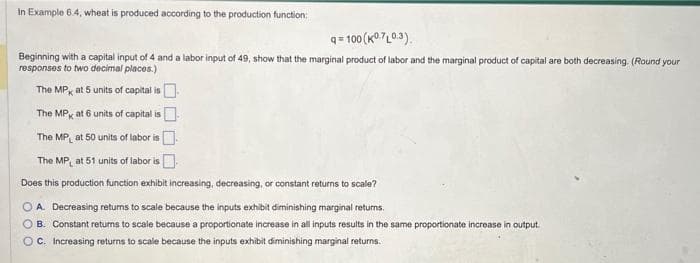In Example 6.4, wheat is produced according to the production function: q=100 (K0.7L0.3). Beginning with a capital input of 4 and a labor input of 49, show that the marginal product of labor and the marginal product of capital are both decreasing. (Round you responses to two decimal places) The MP at 5 units of capital is The MP at 6 units of capital is The MP at 50 units of labor is The MP at 51 units of labor is Does this production function exhibit increasing, decreasing, or constant returns to scale? A. Decreasing returns to scale because the inputs exhibit diminishing marginal returns. B. Constant returns to scale because a proportionate increase in all inputs results in the same proportionate increase in output. OC. Increasing returns to scale because the inputs exhibit diminishing marginal returns.
In Example 6.4, wheat is produced according to the production function: q=100 (K0.7L0.3). Beginning with a capital input of 4 and a labor input of 49, show that the marginal product of labor and the marginal product of capital are both decreasing. (Round you responses to two decimal places) The MP at 5 units of capital is The MP at 6 units of capital is The MP at 50 units of labor is The MP at 51 units of labor is Does this production function exhibit increasing, decreasing, or constant returns to scale? A. Decreasing returns to scale because the inputs exhibit diminishing marginal returns. B. Constant returns to scale because a proportionate increase in all inputs results in the same proportionate increase in output. OC. Increasing returns to scale because the inputs exhibit diminishing marginal returns.
Managerial Economics: Applications, Strategies and Tactics (MindTap Course List)
14th Edition
ISBN:9781305506381
Author:James R. McGuigan, R. Charles Moyer, Frederick H.deB. Harris
Publisher:James R. McGuigan, R. Charles Moyer, Frederick H.deB. Harris
Chapter7: Production Economics
Section: Chapter Questions
Problem 7E
Related questions
Question

Transcribed Image Text:In Example 6.4, wheat is produced according to the production function:
q=100 (K0.7L0.3).
Beginning with a capital input of 4 and a labor input of 49, show that the marginal product of labor and the marginal product of capital are both decreasing. (Round your
responses to two decimal places.)
The MP at 5 units of capital is
The MP
at 6 units of capital is
The MP at 50 units of labor is.
The MP at 51 units of labor is
Does this production function exhibit increasing, decreasing, or constant returns to scale?
OA. Decreasing returns to scale because the inputs exhibit diminishing marginal returns.
OB. Constant returns to scale because a proportionate increase in all inputs results in the same proportionate increase in output.
OC. Increasing returns to scale because the inputs exhibit diminishing marginal returns.
Expert Solution
This question has been solved!
Explore an expertly crafted, step-by-step solution for a thorough understanding of key concepts.
This is a popular solution!
Trending now
This is a popular solution!
Step by step
Solved in 2 steps

Knowledge Booster
Learn more about
Need a deep-dive on the concept behind this application? Look no further. Learn more about this topic, economics and related others by exploring similar questions and additional content below.Recommended textbooks for you

Managerial Economics: Applications, Strategies an…
Economics
ISBN:
9781305506381
Author:
James R. McGuigan, R. Charles Moyer, Frederick H.deB. Harris
Publisher:
Cengage Learning



Managerial Economics: Applications, Strategies an…
Economics
ISBN:
9781305506381
Author:
James R. McGuigan, R. Charles Moyer, Frederick H.deB. Harris
Publisher:
Cengage Learning




